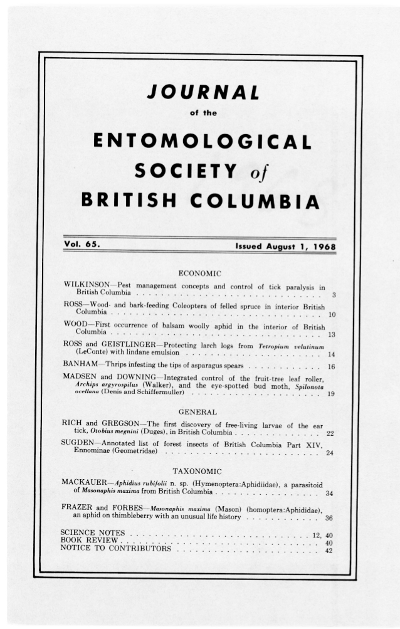Pest management concepts and control of tick paralysis in British Columbia
Keywords:
tick paralysisAbstract
Actual and potential methods for controlling and reducing paralysis of livestock and humans by the tick <i>Dermacentor andersoni</i> Stiles are analyzed, and assigned tentative "Geier ratings" of cost and effectiveness. Four broad categories of control are discussed: protection from toxins, prevention of engorgement, avoidance, and reduction in numbers of ticks. Some control methods are undesirable because of their effects on the eco-system, including game animals. More information is needed on immunology of mammals to tick toxins and tick feeding, on variations and genetics of paralysing ability in ticks, on range management in relation to paralysis, on the effects of herbicides on rodents and ticks, and on life-table parameters of ticks and rodents.References
Barker, R.J., C.F. Cohen and A. Mayer. 1964. Photoflashes: a potential new tool for control of insect populations. Science 145:1195-1197.
Beirne, B.P. 1967. Pest Management. Leonard Hill, London.
Clark, L.R., P.W. Geier, R. D. Hughes, and R. F. Morris. 1967. The ecology of insect populations in theory and practice. Methuen, London.
Cooley, H.A. and G.M. Kohls. 1934. Summary on tick parasites. Proc. 5th Pac. Sci. Congr. 1933 pp. 3375-3381
Drummond, R.0. and D.H. Graham. 1964. Insecticide tests against the tropical horse tick, Dermacentor nitens, on horses. J. Econ. Ent. 57:549-553.
Geier, P.W. 1966. Management of insect pests. Ann. Rev. Ent. 11:471-90.
Gregson, J.D. 1962. The enigma of tick paralysis in North America. Xl Intern. Congr. Ent., Vienna, Proc.. 3:97-101.
Gregson, J.D. 1964. Ticks in relation to certain diseases of man and animals in Canada. Can. Ent. 96:112.
Gregson, J.D. 1966. Records of tick paralysis in livestock in British Columbia. Proc. Entomol. Soc. Brit. Columbia 63:13-18.
Hearle, E. 1938. Insects and allied parasites injurious to livestock and poultry in Canada. Can. Dept. Agr. Publ. No. 604.
Jellison, W L. and J.D. Gregson. 1950. Tick paralysis in Northwestern United States and British Columbia. Rocky Mt. Med. J. 47:28-32.
Kartman, L. 1958. An insecticide bait box method for the control of sylvatic plague vectors. J. Hyg. 56:455-465.
Milne, A. 1949. The ecology of sheep tick, Ixodes ricinus L. Host relation ship of the tick. Parasitology 39:167-172.
Neilson, C.L., G.B. Rich and J.B. Procter. 1966. Livestock pests. Dept. of Agric., Prov. of British Columbia, Victoria, B.C.
Neilson, C.L. and J.D. Gregson. 1967. Ticks and Man in British Columbia. Dept. of Agric. Entomol. Circular 19, Prov. of British Columbia, Victoria, B.C.
Parker, R.R. 1932. Certain phases of the problem of Rocky Mountain spotted fever. Address to American College of Physicians. Reprinted with Additions, from Arch. Pathol. 15:398-429.
Rich, G.B. 1957. The eartick, Otobius megnini (Duges) (Acarina: Argasidae), and its record in British Columbia. Can. J. Comp. Med. 21:415-418.
Riek, R.F. 1958. Studies on the reactions of animals to infestation with ticks. Aust. J. Agric. Res. 9:830-84l.
Riek, R.F. 1962. Studies on the reactions of animals to infestations with ticks. Aust. J. Agric. Res. 13:532-551.
Seddon, H.R. 1951. Tick and mite infestations. Serv. Publ. No. 7 Div. Vet. Hyg. Pub. Hlth Dep., Aust.
Shilova, S.A., M.B. Azaryan, Yu. M. Schadilov. 1967. Organization of the control of forest murine rodents and their ectoparasites in foci of certain natural infections. Med. Parasit. and Parasit. Belezni 36:301-307.
Uspensky, I.V. 1967. A method of direct elimination of tick-borne encephalitis vector. Status and prospects. Med. Parasit. and Parasir. Belezni 36:296-300.
Volkova et al. 1960. Study of the role of ticks of the genera Dermacentor and Haemaphysalis in transmission of brucellosis. Izv. Akad. Nauk Kirghi , S.S.R. 2:5-24.
Translation No. 134. U.S. Navy Med. Res. Unit No.3 Cairo.
Wilkinson, P.R. 1962. Selection of cattle for tick resistance, and the effect of herds of different susceptibility on Boophilus populations. Aust. J. Agric. Res. 13:974-983.
Wilkinson, P.R. 1965. A first record of paralysis of a deer by Dermacentor andersoni Stiles and notes on the "Host-potential" of deer in British Columbia. Proc. Entomol. Soc. Brit. Columbia.62:28-30.
Wilkinson, P.R. and J.E. Lawson. 1965. Differences of sites of attachment or Dermacentor andersoni Stiles to cattle in south-eastern Alberta and south central British Columbia, in relation to possible existence of genetically different strains of ticks. Can. J. Zool. 43:408-411.
Wilkinson, P.R. 1967. The distribution of Dermacentor ticks in Canada in relation to bioclimatic zones. Can. J. Zool. 45:517-537.
Downloads
Published
Issue
Section
License
Authors who publish with the Journal of the Entomological Society of British Columbia agree to the following terms:
-Authors retain copyright and grant the journal right of first publication with the work simultaneously licensed under a Creative Commons Attribution License that allows others to share the work with an acknowledgement of the work's authorship and initial publication in this journal.
-Authors are able to enter into separate, additional contractual arrangements for the non-exclusive distribution of the journal's published version of the work (e.g., post it to an institutional repository or publish it in a book), with an acknowledgement of its initial publication in this journal.
-Authors are permitted and encouraged to post their work online (e.g., in institutional repositories or on their website) prior to and during the submission process, as it can lead to productive exchanges, as well as earlier and greater citation of published work (See The Effect of Open Access).


